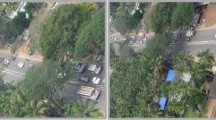Abstract
Passenger car equivalent (PCE) values are necessary for representing a traffic stream composing of different vehicle types in terms of a passenger car equivalent stream. For no lane-based heterogeneous traffic streams observed in India, previous studies mostly have suggested the vehicle-specific PCE values that vary dynamically with the flow rate and the traffic composition. The objective of this paper is to estimate and analyze the implications of the vehicle-specific PCE values that do not vary with the LOS and certain range of traffic composition, for the four-lane and the six-lane divided rural roads. Besides, the present study has also estimated the aggregate PCEs for the four-lane and the six-lane divided roads. The PCE values were estimated based on the macroscopic relationships generated for the base and the heterogeneous traffic streams. For defining the level of service, a new performance measure termed as the speed drop was chosen and it was found that it provides a relatively more accurate PCEs. Results show that for a particular traffic mix, constant PCEs can be used across different levels of service without much loss of accuracy. Aggregate PCEs for a particular traffic mix vary with the speed drop markedly at lower flow rates.











Similar content being viewed by others
References
Mehar A, Chandra S, Velmurugan S (2014) Passenger car units at different levels of service for capacity analysis of multilane interurban highways in India. J Transp Eng 140(1):81–88
Velmurugan S, Madhu E, Ravinder K, Sitaramanjaneyulu K, Gangopadhyay S (2010) Critical evaluation of roadway capacity of multi-lane high speed corridors under heterogeneous traffic conditions through traditional and microscopic simulation models. J Indian Roads Congr 71(3):235–264
St. John AD (1976) Non-linear truck factor for two-lane highways. Transportation Research Record 615. Transportation Research Board, Washington, D.C., pp 49–53
Linzer E, Roess R, McShane W (1979) Effect of trucks, buses, and recreational vehicles on freeway capacity and service volume. Transportation Research Record 699. Transportation Research Board, Washington, D.C., pp 17–26
Webster N, Elefteriadou L (1999) A simulation study of truck passenger car equivalents (PCE) on basic freeway sections. Transp Res Part B 33(5):323–336
Al-Kaisy A, Younghan J, Hesham R (2005) Developing passenger car equivalency factors for heavy vehicles during congestion. J Transp Eng 131(7):514–523
Roess RP, Messer CJ (1984) Passenger car equivalents for uninterrupted flow: revision of circular 212 values. Transportation Research Record 971. Transportation Research Board, Washington, D.C., pp 7–13
Demarchi SH, Setti JR (2003) Limitations of passenger-car equivalent derivation for traffic streams with more than one truck type. Transportation Research Record 1852. Transportation Research Board, Washington, D.C., pp 96–104
Rakha H, Ingle A, Hancock K, Al-Kaisy A (2007) Estimating truck equivalencies for freeway sections. Transportation Research Record 2027. Transportation Research Board, Washington, D.C., pp 73–84
Highway Capacity Manual (2010) Special report 209: fifth edition. Transportation Research Board, Washington, D.C
Indian Roads Congress (1990) Guidelines for the capacity of roads in the rural area. IRC Code of Practice, vol 64, Indian Roads Congress, New Delhi
Mallikarjuna C, Rao KR (2006) Modelling of passenger car equivalency under heterogeneous traffic conditions. In: Proc., 22nd ARRB conference: research into practice, Canberra
Arasan VT, Arkatkar SS (2010) Micro-simulation study of the effect of volume and road width on PCU of vehicles under heterogeneous traffic. J Transp Eng 136(12):1110–1119
Dhamaniya A, Chandra S (2016) Conceptual approach for estimating dynamic passenger car units on urban arterial roads by using simultaneous equations. Transportation Research Record 2553. Transportation Research Board, Washington, D.C., pp 108–116
Biswas S, Chakraborty S, Chandra S, Ghosh I (2016) Kriging-based approach for estimation of vehicular speed and passenger car units on an urban arterial. J Transp Eng 143(3):04016013(1–11)
Geistefeldt J (2009) Estimation of passenger car equivalents based on capacity variability. Transportation Research Record 2130. Transportation Research Board, Washington, D.C., pp 1–6
Huber MJ (1982) Estimation of passenger car equivalents of trucks in the traffic stream. Transportation Research Record 869. Transportation Research Board, Washington, D.C., pp 60–70
Sumner R, Hill D, Shapiro S (1984) Segment passenger car equivalent values for cost allocation on urban arterial roads. Transp Res Part A 18(5/6):399–406
Krammes RA, Crowley KW (1986) Passenger car equivalents for trucks on level freeway segments. Transportation Research Record 1091. Transportation Research Board, Washington, D.C., pp 10–17
Mallikarjuna C, Rao KR (2011) Heterogeneous traffic flow modelling: a complete methodology. Transportmetrica 7(5):321–345
Pal D (2016) Analysis and modeling of vehicular movement in no-lane-disciplined heterogeneous traffic stream. Ph. D Thesis, Indian Institute of Technology Guwahati, Guwahati
Mallikarjuna C, Phanindra A, Rao KR (2009) Traffic data collection under mixed traffic conditions using video image processing. J Transp Eng 135(4):174–182
Mallikarjuna C (2007) Analysis and modeling of heterogeneous traffic. Ph. D Thesis, Indian Institute of Technology Delhi, New Delhi
Pal D, Mallikarjuna C (2017) Modelling of lateral gap maintaining behaviour of vehicles in heterogeneous traffic stream. Transp Lett 2017:1–9
Del Castillo JM, Benitez FG (1995) On the functional form of the speed-density relationship—I: general theory. Transp Res Part B 29(5):373–389
Mehar A (2013) Capacity analysis on multilane highways in mixed traffic conditions. Ph. D Thesis, Indian Institute of Technology Roorkee, Roorkee
Author information
Authors and Affiliations
Corresponding author
Rights and permissions
About this article
Cite this article
Ballari, S.O., Kar, P. & Chunchu, M. Passenger Car Equivalents for the Heterogeneous Traffic on Divided Rural Highways Based on Simulation Model. Transp. in Dev. Econ. 4, 14 (2018). https://doi.org/10.1007/s40890-018-0067-z
Received:
Accepted:
Published:
DOI: https://doi.org/10.1007/s40890-018-0067-z




